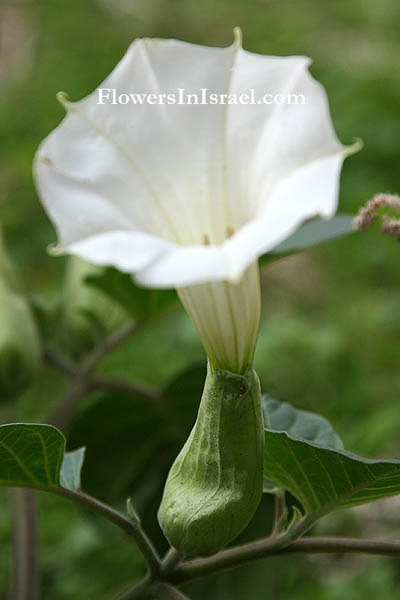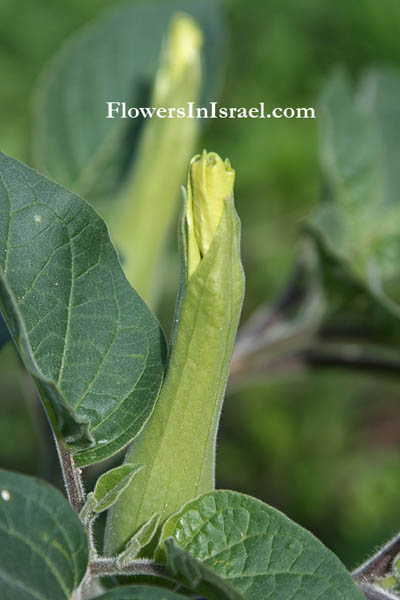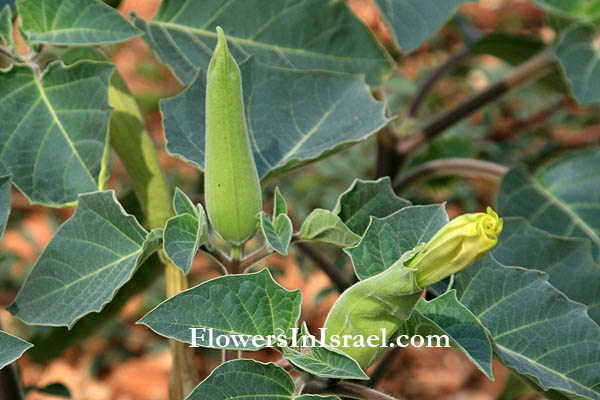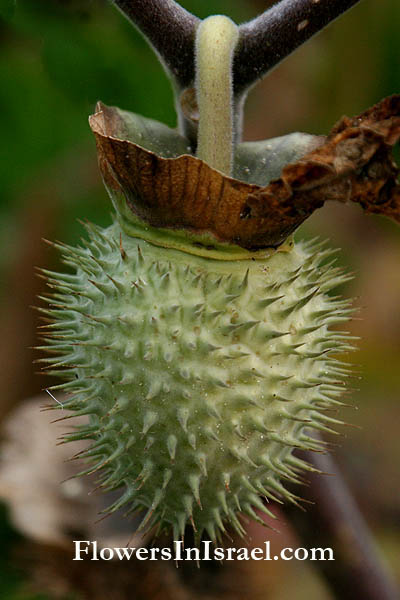Downwards Thornapple, Angel's trumpet, Horn-of plenty,
Desert thornapple, Sacred datura,Hebrew: דטורה נטויית-פרי, Arabic: داتورا
| Scientific name: | Datura innoxia Miller | |
| Synonym name: | Datura meteloides DC. ex Dunal, Datura metel L., sensu Fassett | |
| Common name: | Downwards Thornapple, Angel's trumpet, Horn-of plenty, Desert thornapple, Sacred datura | |
| Hebrew name: | דטורה נטויית-פרי, datura | |
| Arabic name: | داتورا, datura | |
| Plant Family: | Solanaceae, סולניים |

|
| Life form: | Annual | |
| Stems: | 120-180 cm; semiwoody and suffruticose | |
| Leaves: | Alternate, entire | |
| Flowers: | White, tubular, axillary, usually solitary, nodding, 5-toothed calyx 5 to 7 cm long | |
| Fruits / pods: | Capsule, ovoid, nodding, about 3 cm in diameter, covered with stout, soft prickles 2 to 4 mm long; yellowish-brown seeds, flat, kidney-shaped, about 5 mm long, and have a small fleshy aril | |
| Flowering Period: | June, July, August, September, October, November | |
| Habitat: | Cultivated areas | |
| Distribution: | Mediterranean Woodlands and Shrublands, Semi-steppe shrublands, Shrub-steppes, Deserts and extreme deserts | |
| Chorotype: | Pluriregional | |
| Summer shedding: | Ephemeral |

Location: Carmel, Ramat Hanadiv Derivation of the botanical name: Datura metel derives its specific name from the jous-methel, or “metel nut,” of the Arabic pharmacopaea, described by Avicenna, Ibn-Sina (980-1037), a foremost Persian doctor and philosopher and scientist who was born in a small town near Bukhara (Uzbekistan) and died in Persia. From Dioscorides' translation of Avicenna*s description, this so-called nut was recognized by Pietro Andrea Mattioli (1500-1577) and other early botanists as the fruit of a solanaceous plant, which was figured in 1542 by Fuchsius, Leonhart Fuchs (1501-1566), under the name ''Stramonia, or Rauchaepffelkraut." In establishing the genus Datura two centuries later, Linnaeus formed a generic name from the East Indian Dutra, or Dhatura, giving it a a Latin form, and explaining it by the following pun: “Daturae, licet originis sit peregrinae, vocabulum persistere valet, cum a Latina derivari potest; dantur et daturae forte in Indiis posthac semina a lascivis foeminis maritis inertibus.” innoxia, harmless, i.e. lacking poisonous properties, spines, bristles, etc. The specific epithet is sometimes transcribed as 'innoxia,' but the original spelling was with a single 'n'. The Hebrew name: דטורה, datura, transliteration from the scientific name.
In Israel, we find the Datura in the Mediterranean Woodlands and Shrublands, Semi-steppe shrublands, Shrub-steppes, Deserts, and extreme deserts. The stems and the undersides of the leaves of the Datura inoxia are covered by a velvety down of fine hairs. Leaves are arranged alternately (one leaf per node) along the branches 6 - 20 cm long and 3 - 12 cm wide and dark-green. The flowers are white, trumpet-shaped and 15 - 17 cm long and made of five segments. Flower buds are initially erect, but tend to droop at flowering and the seed heads point downwards. Seed heads, about 3 cm in diameter, are covered with numerous spines 5 - 10 mm in length and because of its spiny fruit; it is also known as 'thorn apple'. When the 'apple' is ripe, the capsule opens up into four segments, thus releasing its little black to pale-brown seeds. All parts of Datura inoxia are poisonous and contain Atropine, hyoscine, and hyoscyamine. All species of Datura have been used by native peoples of the Southwestern US in puberty and other ceremonies, because of their hallucinogenic alkaloids and have caused poisoning and death in humans and animals. It is known as 'loco weed' because of its effect on cattle. From historical accounts recorded by the Conquistadors, the Spanish conquerors of Mexico or Peru in the 16th century, we know that the Aztecs and other Indians, who had a detailed knowledge about numerous sacred and medicinal plants, were familiar with several types of Datura species. One of these Daturas was called Toloache and is probably Datura inoxia. In the New World, the Catholic Church was forced to sanctify the old pre-Christian deity 'Santo Toloache', the patron Saint of Datura. Santo Toloache helps those who wish for reciprocated love. The faithful worshipers who pray to him make offerings of Datura flowers and take a tea of Datura leaves as a special sacrament. The ancient use of Datura as a powerful aphrodisiac is taken for granted. It was used as a painkiller in certain initiation rituals and given as a narcotic to the ritual sacrifices. For this purpose, the preferred method of administration was either by enema or as a rolled-up leaf suppository, which reduces some of the less pleasant side effects of the drug. General symptoms of poisoning are agitation, choreiform (spasmodic) movement, coma, drowsiness, hallucination, elevated temperature. 
Location: Carmel, Ramat Hanadiv 
Location: Herzliya, Winter pool |